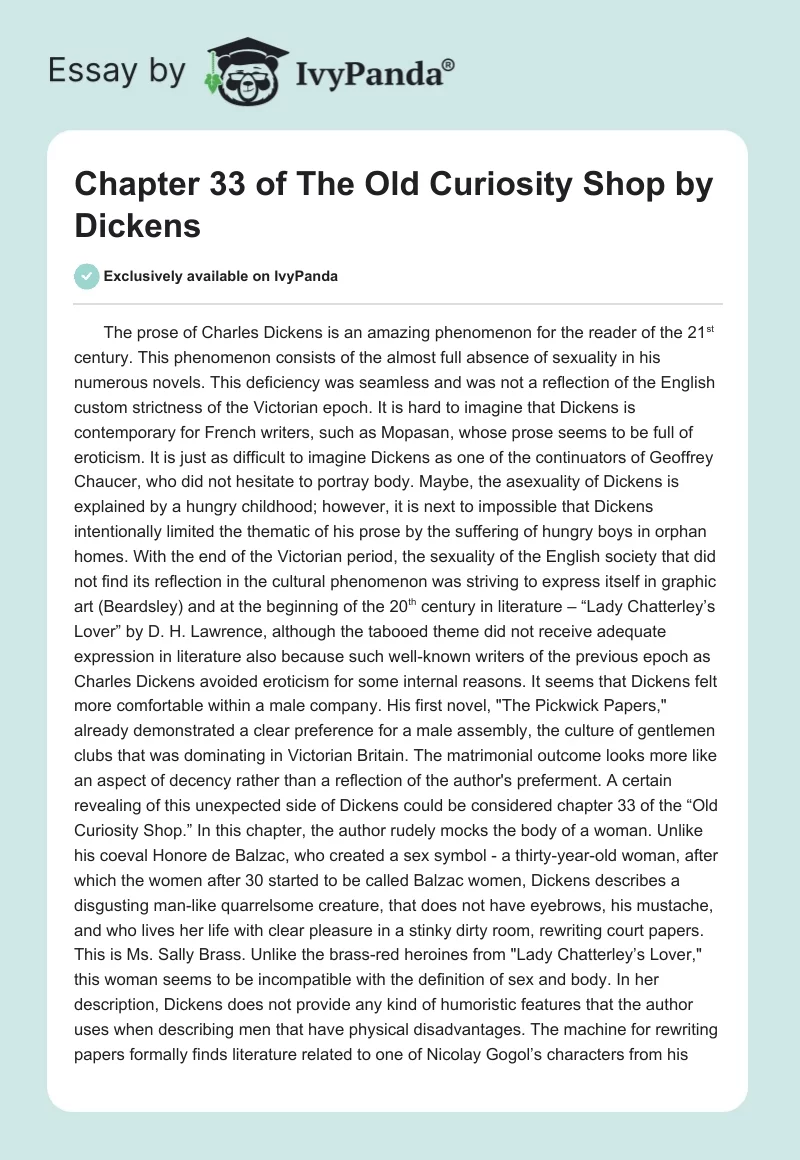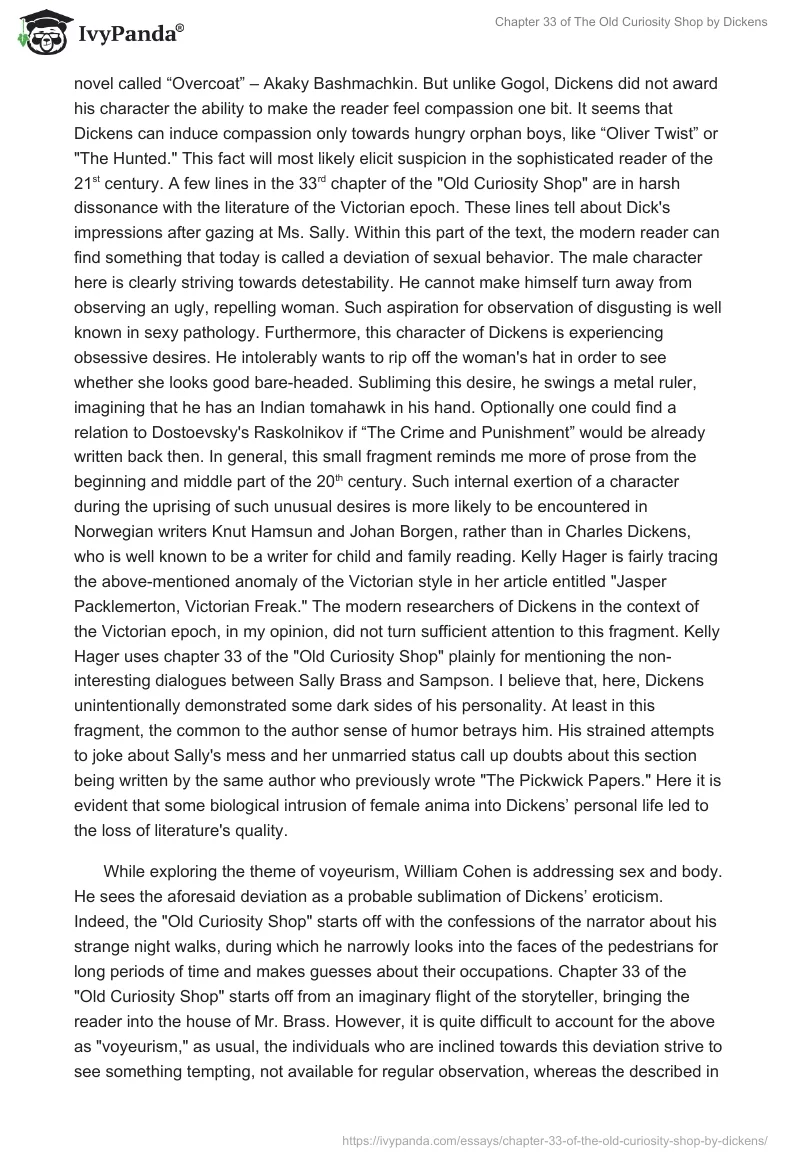The prose of Charles Dickens is an amazing phenomenon for the reader of the 21st century. This phenomenon consists of the almost full absence of sexuality in his numerous novels. This deficiency was seamless and was not a reflection of the English custom strictness of the Victorian epoch. It is hard to imagine that Dickens is contemporary for French writers, such as Mopasan, whose prose seems to be full of eroticism. It is just as difficult to imagine Dickens as one of the continuators of Geoffrey Chaucer, who did not hesitate to portray body. Maybe, the asexuality of Dickens is explained by a hungry childhood; however, it is next to impossible that Dickens intentionally limited the thematic of his prose by the suffering of hungry boys in orphan homes. With the end of the Victorian period, the sexuality of the English society that did not find its reflection in the cultural phenomenon was striving to express itself in graphic art (Beardsley) and at the beginning of the 20th century in literature – “Lady Chatterley’s Lover” by D. H. Lawrence, although the tabooed theme did not receive adequate expression in literature also because such well-known writers of the previous epoch as Charles Dickens avoided eroticism for some internal reasons. It seems that Dickens felt more comfortable within a male company. His first novel, “The Pickwick Papers,” already demonstrated a clear preference for a male assembly, the culture of gentlemen clubs that was dominating in Victorian Britain. The matrimonial outcome looks more like an aspect of decency rather than a reflection of the author’s preferment. A certain revealing of this unexpected side of Dickens could be considered chapter 33 of the “Old Curiosity Shop.” In this chapter, the author rudely mocks the body of a woman. Unlike his coeval Honore de Balzac, who created a sex symbol – a thirty-year-old woman, after which the women after 30 started to be called Balzac women, Dickens describes a disgusting man-like quarrelsome creature, that does not have eyebrows, his mustache, and who lives her life with clear pleasure in a stinky dirty room, rewriting court papers. This is Ms. Sally Brass. Unlike the brass-red heroines from “Lady Chatterley’s Lover,” this woman seems to be incompatible with the definition of sex and body. In her description, Dickens does not provide any kind of humoristic features that the author uses when describing men that have physical disadvantages. The machine for rewriting papers formally finds literature related to one of Nicolay Gogol’s characters from his novel called “Overcoat” – Akaky Bashmachkin. But unlike Gogol, Dickens did not award his character the ability to make the reader feel compassion one bit. It seems that Dickens can induce compassion only towards hungry orphan boys, like “Oliver Twist” or “The Hunted.” This fact will most likely elicit suspicion in the sophisticated reader of the 21st century. A few lines in the 33rd chapter of the “Old Curiosity Shop” are in harsh dissonance with the literature of the Victorian epoch. These lines tell about Dick’s impressions after gazing at Ms. Sally. Within this part of the text, the modern reader can find something that today is called a deviation of sexual behavior. The male character here is clearly striving towards detestability. He cannot make himself turn away from observing an ugly, repelling woman. Such aspiration for observation of disgusting is well known in sexy pathology. Furthermore, this character of Dickens is experiencing obsessive desires. He intolerably wants to rip off the woman’s hat in order to see whether she looks good bare-headed. Subliming this desire, he swings a metal ruler, imagining that he has an Indian tomahawk in his hand. Optionally one could find a relation to Dostoevsky’s Raskolnikov if “The Crime and Punishment” would be already written back then. In general, this small fragment reminds me more of prose from the beginning and middle part of the 20th century. Such internal exertion of a character during the uprising of such unusual desires is more likely to be encountered in Norwegian writers Knut Hamsun and Johan Borgen, rather than in Charles Dickens, who is well known to be a writer for child and family reading. Kelly Hager is fairly tracing the above-mentioned anomaly of the Victorian style in her article entitled “Jasper Packlemerton, Victorian Freak.” The modern researchers of Dickens in the context of the Victorian epoch, in my opinion, did not turn sufficient attention to this fragment. Kelly Hager uses chapter 33 of the “Old Curiosity Shop” plainly for mentioning the non-interesting dialogues between Sally Brass and Sampson. I believe that, here, Dickens unintentionally demonstrated some dark sides of his personality. At least in this fragment, the common to the author sense of humor betrays him. His strained attempts to joke about Sally’s mess and her unmarried status call up doubts about this section being written by the same author who previously wrote “The Pickwick Papers.” Here it is evident that some biological intrusion of female anima into Dickens’ personal life led to the loss of literature’s quality.
While exploring the theme of voyeurism, William Cohen is addressing sex and body. He sees the aforesaid deviation as a probable sublimation of Dickens’ eroticism. Indeed, the “Old Curiosity Shop” starts off with the confessions of the narrator about his strange night walks, during which he narrowly looks into the faces of the pedestrians for long periods of time and makes guesses about their occupations. Chapter 33 of the “Old Curiosity Shop” starts off from an imaginary flight of the storyteller, bringing the reader into the house of Mr. Brass. However, it is quite difficult to account for the above as “voyeurism,” as usual, the individuals who are inclined towards this deviation strive to see something tempting, not available for regular observation, whereas the described in chapter 33 tacky house of Mr. Brass rouses no temptation, and just strengthens the disgust towards Ms. Sally Brass, her bony stature, and red her nose. There are no libidinous descriptions of bed scenes that could be used to blame the author in voyeurism – the strive towards spying on unfamiliar life. Chapter 33 of the “Old Curiosity Shop” gives reasons to suppose that sexuality, sex, eroticism – the themes tabooed in the Victorian society, at least in their most common version, in reality, were not interesting to the author, and he sincerely did not intend to fascinate his readers with these subjects. The reason for this phenomenon could be the topic of future studies, as the works of Kelly Hager and William A. Cohen trace these themes quite insufficiently. At the same time, this peculiarity of Charles Dickens’ personality that got reflected in his creative literary works did not allow him to profoundly mirror human nature, despite doubtless, and even immense literature talent. The seamless Dickens ignoring of human sexuality had seriously limited his influence on the culture of the 19th century. Unfortunately, the writers who later attempted to supplement the sexuality breach did not possess even one-tenth of the talent of Dickens and therefore were unable to reflect this subject in English literature. The indicated gap in Dickens’ creative work allowed the later mockery of him that got mirrored, for example, in Evelyn Waugh’s novel, entitled “A Handful Of Dust,” where the protagonist is doomed to reading out loud the novels by Charles Dickens to a leader of a primitive tribe in the wilderness of the Amazon river, who forcedly hold this British aristocrat as a hostage. It is hard to imagine that the reading of Lev Tolstoy could occur under the same conditions, that is to say, that the harsh irony of Evelyn Waugh captured an innate defect of Dickens’ work that prevented the author from overcoming the few invisible inches that separated his talented literature for home reading from great literature that has the ability to alter and exalt a human mind.
Works Cited
Cohen, William A. “Interiors: Sex and the Body in Dickens” Critical Survey 17.2 (2005): 5+. Questia. Web.
Hager, Kelly. “Jasper Packlemerton, Victorian Freak.” Victorian Literature and Culture, Cambridge University Press (2006), 34:209-232


